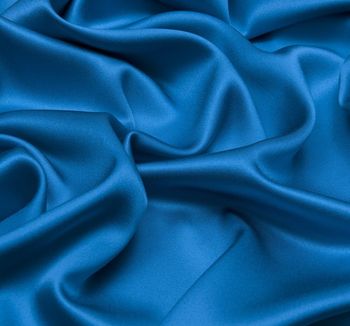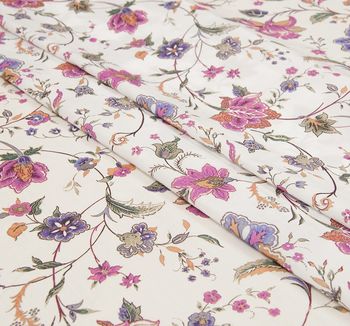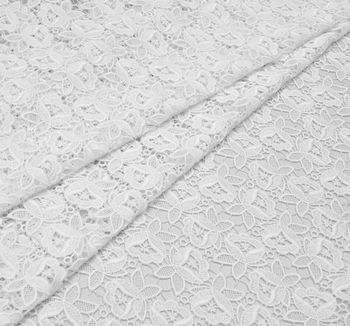Silk is a timelessly trendy natural fabric woven from the cocoons of silk worms. The world’s most famous fashion brands regularly apply it for various men’s and women’s outfits earning the admiration of the audience.
Sewing Buttons
Sewing buttons are a type of fastener attached to a garment in order to secure an opening either by passing it through a loop or a buttonhole. It can be made of various materials, including wood, horn, metal and mother of pearl, as well as plastic.
Sewing buttons vary in shapes, sizes, colors and designs. Some people also use buttons to decorate their craft projects, such as toys, pillows, or curtains, or for scrapbooking.
.jpg)
Traditionally, men and women wear buttons on different sides of a placket. Rumour has it, men have always dressed themselves, and since most people are right-handed, buttons were attached to the right side of a man’s garment. Women, on the other hand, required help in dressing, so buttons were attached to the left side to make it easier for a helper (usually a maid) to fasten them.
What Are the Different Types of Buttons?
There are many types of buttons out there. First of all, they are all divided into flat buttons (also known as sew-through buttons, with either two or four holes) and shank buttons (with a hollow detail on the back through which it is attached to the garment). Both types are widely used in fashion design and DIY projects.
Sewing buttons can be classified based on their shape. Here are the most common ones:
- round buttons,
- square buttons,
- ball buttons,
- flower buttons,
- fashion buttons.
You can also distinguish them according to their end use, i.e. which garments they are intended to be sewn onto:
- dress buttons,
- shirt buttons,
- suit buttons,
- coat buttons, etc.
Mind that many buttons are multifunctional, which means you can use one and the same fastener for various clothes.
What Are Buttons Made of?
Buttons can be made of all kinds of materials. The first buttons date back to the 13th century. The most expensive ones were made of gold, silver, and ivory and were worn both as decorations and fastenings. They were often adorned with precious gems to show the status of an owner. There were also cheaper versions made of cheaper materials, and those were used by less prosperous people. These materials are still in use today, and you can buy them both offline and online almost in any fabric shop.
So, what are the most popular buttons currently available? Here’s a little table for you:
| Button Type | Button Material | End Use |
|---|---|---|
|
Metal buttons |
Metal alloys with steel, nickel, zinc, brass, etc. |
Leather, denim clothes |
|
Horn buttons |
Cow, buffalo, ox, deer horns and hooves |
Men’s suits, jackets, blazers |
|
Mother of pearl buttons |
Nacre, or sea shells: abalone, trocas, etc. |
Shirts, blouses, dresses |
|
Jewelry buttons |
Precious stones shaped like buttons, metal buttons adorned with precious gems, Swarovski crystals, etc. |
Evening wear, fancy jackets |
|
Bone buttons |
Cow, buffalo, ox bone |
Men’s suits, jackets, blazers |
|
Wooden buttons |
Various types of wood, e.g. bamboo and olive |
Used mainly for decoration purposes, because they are less durable |
|
Pearl buttons |
Genuine pearls |
Women’s dresses, shirts, blouses, lingerie |
|
Fabric buttons |
Covered with any type of textile material, ribbon, passementarie, etc. |
Women's apparel, traditional Chinese outfits |
|
Enamel buttons |
100% enamel or covered with enamel |
Women’s dresses, blouses, shirts, skirts |
|
Plastic buttons |
A variety of synthetic materials, e.g. polyester |
Women's, men's, kids' wear |
In fact, there are many more kinds of buttons: from glass and ceramic to galalith and corozo. The range of designs available strikes imagination. These days, you can buy embossed metal buttons ideal for blazers, embroidered buttons perfect for evening fashion, printed buttons great for modern stylish pieces. If you’re looking for something really unique, try novelty buttons: these are real attention-grabbers that can take any form you want, be it a star, a Santa Clause or a coffee cup.
Choosing Button Sizes
How may button sizes do you know? To begin with, there are three main size categories:
- small,
- medium, and
- large.
Small buttons are ideal for kids’ dresses and shirts, while large buttons look gorgeous on oversize jackets and coats.
All buttons are measured in lignes, or lines (the abbreviated form is L). One ligne equals to 0.025 inch, which is 0.635 mm. This measurement system applies to all shapes. Technically, L indicates a button’s diameter, precisely, the outer largest diameter (if a button is anything but round). The larger the number, the bigger the button.
How do you select the size that is right for your project? There’s no strict rule to it, and every sewist gets to choose what they want. However, the most common button sizes for a shirt would be 12L, 16L, and 18L. Suit jackets usually require 32L buttons.
Below is the size chart you might find useful when choosing buttons:
| Ligne | mm | inches |
|---|---|---|
|
10 |
6.35 |
0.25 |
|
12 |
7.62 |
0.300 |
|
14 |
9.2 |
0.362 |
|
16 |
10.5 |
0.413 |
|
18 |
11.6 |
0.457 |
|
20 |
12.7 |
0.500 |
|
22 |
14.2 |
0.559 |
|
24 |
15.0 |
0.590 |
|
26 |
16.51 |
0.650 |
|
28 |
17.8 |
0.701 |
|
30 |
19.0 |
0.748 |
|
32 |
20.5 |
0.807 |
|
34 |
21.5 |
0.846 |
|
36 |
22.9 |
0.902 |
|
38 |
24.13 |
0.950 |
|
40 |
25.4 |
1.000 |
|
60 |
38.1 |
1.500 |
Fashion and Designer Buttons
Sometimes you need a very peculiar button to finish off your look. Here’s when fashion and designer buttons come in handy.
Fashion buttons make a very stylish impact. They can easily become a centerpiece of an outfit and catch everybody’s attention. There are exclusive buttons which look like jewelry: encrusted with crystals, rhinestones, gems, or pearls, they sparkle brightly in the light.
Designer buttons come in limited editions. Created by talented designers, they are really unique, and the variety of options is limitless. From whimsical ornaments and handcrafted images to color blocks and carved out designs, this is the case when imagination rules it all.
When choosing buttons, consider several factors. Is it large enough? Do you like the shape and the color? Are you satisfied with the material? Is it trendy? Eventually, it all comes down to your preferences.
The 2017 fashion collections were all about buttons. They were seen on slit skirts and coats, on dresses and pant suits. Large buttons are still having their moment of glory: put them in one clean line and choose minimalist silhouettes. Contrasting exaggerated buttons are also a hit!
Buying Dress, Shirt and Coat Buttons Online
Tissura carries a large selection of dress buttons, shirt buttons and coat buttons in a variety of materials. Be sure to browse the catalogue to see them all: natural horn and iridescent mother of pearl, galalith and Swarovski crystals, textile and wood! Buy online the sewing buttons supplied by the most famous manufacturers based in Europe:
- Secondo Stefano Pavese
- Modapierre
- Zanchi Giovanni
- Gritti
- Baldini, and many others.
Shopping for buttons has never been easier!
Rhinestone button, 23 € (29 US$)
Rhinestone button, 58 € (72 US$)
Horn button, 5.90 € (7.30 US$)
Mother of pearl button, 14 € (17.40 US$)
How to stay cool on a hot summer day? Wear fabrics built for the heat. Cotton, linen, viscose, silk – there are dozens of summer-friendly materials you can choose for your wardrobe. The best fabric to opt for when the temperature rises should be breathable and comfortable.
The wedding dress is one of the most important clothing items a woman gets to choose in her lifetime. It can be made of silk or cotton, lace or tulle, be strewn with sequins or embroidered with beads.
.jpg)
.jpg)
.jpg)
.jpg)


